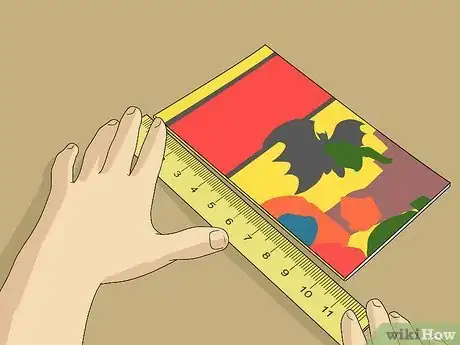wikiHow is a “wiki,” similar to Wikipedia, which means that many of our articles are co-written by multiple authors. To create this article, 9 people, some anonymous, worked to edit and improve it over time.
There are 8 references cited in this article, which can be found at the bottom of the page.
This article has been viewed 183,674 times.
Learn more...
Comic books have been a popular storytelling medium since the mid-1930s. Although the hobby of collecting comic books is not quite as old, it has spawned an industry of providing collectors with bags, boards, and boxes to preserve their comics in. For the best use of these preserving materials, it's important to know how to size your comic books for proper storage. The steps below provide you with guidelines in choosing the right size of storage materials for your comics collection.
Steps
-
1Know the difference in "standard" comic book sizes. The earliest comic books of the Golden Age contained 64 pages, enough to support 4 or 5 adventures within their covers. As the cost of paper gradually increased, the number of pages was reduced to 48, which accommodated up to 3 graphic stories, and then to 32, which usually meant a maximum of 2 stories. Also, while comic books consistently kept a height of 10 1/2 inches (26.7 cm), their width narrowed from the Golden Age dimension of 7 3/4 inches (19.7 cm) to a Silver Age width of 7 1/8 inches (18.1 cm), then widened to 7 1/4 inches (18.4 cm) in the 1970s and 1980s before narrowing to 6 7/8 inches (17.5 cm) in the 1990s. Bags for regular comics are thus broken into the following sizes:
- Golden Age: 7 3/4 x 10 1/2 inches (19.7 x 26.7 cm). This size accommodates Golden Age comics from 1943 up to Silver Age comics published in 1960.
- Silver Age: 7 1/8 x 10 1/2 inches (18.1 x 26.7 cm). This size accommodates some late Golden Age comics published in 1951 as well as Silver Age comics published as late as 1965, including annuals and 80-page giants published during that period.
- Regular: 7 1/4 x 10 1/2 inches (18.4 x 26.7 cm). This size accommodates comics published after 1965, including the late Silver Age and Bronze Age comics of the 1970s to mid-1980s.
- Current: 6 7/8 x 10 1/2 inches (17.5 x 26.7 cm). This size accommodates comics published since 1990.
- As there is some overlap in years in the above list, be sure to measure your comics horizontally and vertically before purchasing bags and boards for them.
-
2Note that some comic books have been published in magazine format. Although most comic book series have been published in 1 of the sizes described above, some comics have been published in larger magazine formats, particularly from the late 1960s into the early 1980s. Bags and boards are available for these magazine comics in these sizes:
- Magazine: 8 1/2 x 11 inches (21.7 x 27.9 cm). This size will accommodate Warren Comics titles such as "Creepy," "Eerie," and "Vampirella," and Curtis' black-and-white adaptations of Marvel titles such as "Conan, the Barbarian" and "The Rampaging Hulk," as well as issues of Mad Magazine.
- Thick Magazine: 8 3/4 x 11 inches (22.2 x 27.9 cm). This size will accommodate the color comic "Heavy Metal" as well as issues of "Playboy" and other men's magazines.
Advertisement -
3Get larger bags and boards still for treasury-sized comics. Treasury comics are larger than magazine-sized comics used for reprints, such as DC Comics Famous First Edition reprints of the Golden Age comics featuring first appearances of its major characters, Christmas story reprint anthologies from both DC and Marvel, and special issues such as DC's "Superman vs. Muhammad Ali." Treasury sized bags and boards measure 10 5/8 inches ( cm) across by 13 1/2 inches ( cm) high.
-
4Choose the form of plastic that best meets your needs. Comic book preservation supplies are available from your local comic shop or from an Internet retailer. Comic book bags are made of any of several kinds of plastic: polypropylene, polyethylene, and Mylar. Polypropylene and polyethylene run cheaper than Mylar, but typically must be replaced every 3 to 5 years, along with the backing board, so the comic remains preserved. Mylar, in contrast, does not need to be replaced as often, but not all dealers carry Mylar bags in all sizes.
Community Q&A
-
QuestionHow do I store thick comic books from the Silver and Golden Age?
 Community Answerif you're referring to the 100 page spectaculars that were typical in that era, you will find they fit snugly but fine in a standard Golden Age comic book bag.
Community Answerif you're referring to the 100 page spectaculars that were typical in that era, you will find they fit snugly but fine in a standard Golden Age comic book bag. -
QuestionHow do I fit old comics for storage?
 Community AnswerIn order to store comic books in the best condition, people typically use large boxes. No special type in particular, but a box. If you really do want to keep the comics in the best condition, then you might want to seal them in bags before putting them in boxes.
Community AnswerIn order to store comic books in the best condition, people typically use large boxes. No special type in particular, but a box. If you really do want to keep the comics in the best condition, then you might want to seal them in bags before putting them in boxes.
Warnings
- Be aware that not all comics are equally valued by collectors. Comics produced from the 1980s onward were produced in greater quantities than those prior to that time and therefore are less valuable (and first issues, first appearances of popular characters, or iconic and well-liked stories, tend to sell better than later stories or less-famous characters or stories). With rare exceptions, modern comics almost never rise in value much more than their cover price; even beloved variant covers rarely become worth more than $20, even given a few years' time, without other factors. Nonetheless, if you value your comics for the stories and art inside them, there is nothing wrong with preserving those comics by placing them in bags of the correct size.⧼thumbs_response⧽
References
- http://www.findingdulcinea.com/guides/Entertainment/Books/Comic-Books.pg_00.html#00
- http://www.2-clicks-comics.com/article/how-to-store-comics.html
- http://www.comicbookdaily.com/daily_news/collecting-and-investing-tips-8/
- http://beadlinks.com/46213.php
- http://www.milehighcomics.com/supplies/
- http://www.mycomicshop.com/comicsupplies?dep=125025
- Rodney Ruff, Omaha, NE; lifelong comics fan
- "Boarding" and boxing/bin tips from Jamie Trosa, long-term comics collector, archival picture framer, and employee of The Finishing Touch Framing & Restoration (a shop in Melbourne, Fl specializing in among other things, archival picture framing, care and handling of memorabilia, and paper art restorations)































































